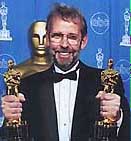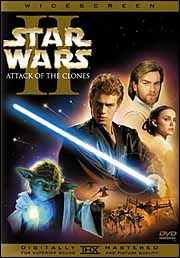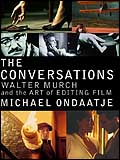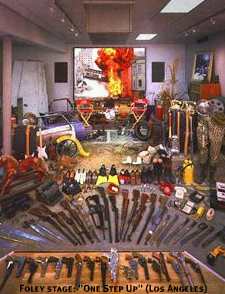|
Film's unsung hero

The
art of sound-effects is named after a movie pioneer who never got
screen recognition for his work. Today's foley artists make the credit
roll, but they're just as invisible


By JENNIE PUNTER

|
'Rock
Hudson is a solid stepper; Tony Curtis has a brisk foot; Audie Murphy
is springy; James Cagney is clipped.'
Jack
Foley describing the footsteps of the stars in 1962
|
 In
the 33 years that sound-effects pioneer Jack Foley worked on Stage
10 at Universal Studios, he never received an on-screen credit for his
inventive, and sometimes cost-saving contributions. But the art he single-handedly
created in the early days of the "talkies" was eventually named after
him and is part of every feature film showing at the local multiplex. In
the 33 years that sound-effects pioneer Jack Foley worked on Stage
10 at Universal Studios, he never received an on-screen credit for his
inventive, and sometimes cost-saving contributions. But the art he single-handedly
created in the early days of the "talkies" was eventually named after
him and is part of every feature film showing at the local multiplex.
Almost every sound we hear
at the movies that isn't dialogue or music is a sound effect. From
footsteps to gunshots, from the faint rustle of clothing to the fiery
roar of a jet, sound is either created by a foley artist or deliberately
placed there by a sound editor, who either went out to record it or selected
it from a vast library, and possibly combined it with other sounds or
altered its pitch.
Many early sound pictures
had dialogue and music but no feeling of the noise of movement. Soon
editors started cutting together footstep sounds for actors, but would
use the same tracks over and over. Foley got the idea of projecting the
moving image in a sound stage and recording sounds in sync with the actors'
movements, using different surfaces and an array of props. It was said
that Foley could make the sound of three men walking together using only
his two feet and a cane.
 His
last foley job was on Spartacus.
Director Stanley Kubrick wanted to reshoot the Roman army marching to
battle because the location sound was no good. Foley ran out to his car
and retrieved a large ring of keys, which he then jangled in sync to the
march step, creating the rhythmic "ching" of the armour and saving production
the expense of a two-day shoot with soldier extras. Today's
foley artists follow the techniques established by Foley (who died in
1967), but unlike him, they get credit for their work. His
last foley job was on Spartacus.
Director Stanley Kubrick wanted to reshoot the Roman army marching to
battle because the location sound was no good. Foley ran out to his car
and retrieved a large ring of keys, which he then jangled in sync to the
march step, creating the rhythmic "ching" of the armour and saving production
the expense of a two-day shoot with soldier extras. Today's
foley artists follow the techniques established by Foley (who died in
1967), but unlike him, they get credit for their work.
 Andy
Malcolm, one of the best-known names in the business, is
a Genie Award-nominee for best sound editing in 2002 for his foley work
in Max
and David Cronenberg's Spider.
Asked to describe his
job, he says: "While the dialogue editor is stuck in front of a computer,
I'm on my feet all day throwing car doors around and punching roasted
chickens." Andy
Malcolm, one of the best-known names in the business, is
a Genie Award-nominee for best sound editing in 2002 for his foley work
in Max
and David Cronenberg's Spider.
Asked to describe his
job, he says: "While the dialogue editor is stuck in front of a computer,
I'm on my feet all day throwing car doors around and punching roasted
chickens."
Malcolm has been doing foley
work since the mid-seventies, but started working out of his own home
in Uxbridge, Ont., just three years ago. "The studio is built on the ground
floor," he explains, "and there's a room delegated for exteriors with
a huge dirt pit, asphalt, cobblestone and grass growing under a sun lamp.
So it's great for clomping through the dirt or digging a grave."
 Malcolm
and his team did the foley work for Atanarjuat:
The Fast Runner, the first Inuit feature film, in the month of
July. "The powers that be didn't think we could do it," Malcolm says.
"But we brought in huge sculpting blocks of ice and sent a driver to the
arena to pick up snow from the Zamboni. Then we layered it with cornstarch,"
he adds, noting that's what creates that crunchy snow sound. Malcolm
and his team did the foley work for Atanarjuat:
The Fast Runner, the first Inuit feature film, in the month of
July. "The powers that be didn't think we could do it," Malcolm says.
"But we brought in huge sculpting blocks of ice and sent a driver to the
arena to pick up snow from the Zamboni. Then we layered it with cornstarch,"
he adds, noting that's what creates that crunchy snow sound.
 Foley
artists love squeaky things. Malcolm won't allow WD40 in his house,
which he has wired for sound. "The whole end sequence of Red
Dragon [the second Hannibal Lecter sequel] takes place in a beach
house and we did the foley for that in my house." For
scenes like this, Malcolm uses portable monitors to watch the action.
Digital-recording technology also allows him to do "location" foley, which
he has done for such films as Lolita, Sunshine and The
Sweet Hereafter. Foley
artists love squeaky things. Malcolm won't allow WD40 in his house,
which he has wired for sound. "The whole end sequence of Red
Dragon [the second Hannibal Lecter sequel] takes place in a beach
house and we did the foley for that in my house." For
scenes like this, Malcolm uses portable monitors to watch the action.
Digital-recording technology also allows him to do "location" foley, which
he has done for such films as Lolita, Sunshine and The
Sweet Hereafter.
"The technology is affordable
now, so we have a portable setup which we can take to a location.
The whole dynamic range of sound is so much better it actually makes our
job more intense. We've got as many tracks at our disposal as we need."
Mechanical sound in film
marked its 75th anniversary last year.
 Experiments
in synchronized sound and moving image were happening long before
The
Jazz Singer -- the Warner Bros. film that wowed audiences in 1927
and that changed commercial filmmaking almost overnight. Still, movies
have been trying to catch up with developments in sound technology ever
since. Although creativity has flourished throughout the history of film
sound, costs of updating equipment and theatre sound systems prevented
most moviegoers from fully experiencing the artistry. Lately, however,
things have changed. Thanks to digital technology and the multiplex construction
boom in cities and suburbs across the land in the late nineties, movies
have never sounded so good. But
some things haven't changed since 1927. Sound is still invisible, so to
speak. Experiments
in synchronized sound and moving image were happening long before
The
Jazz Singer -- the Warner Bros. film that wowed audiences in 1927
and that changed commercial filmmaking almost overnight. Still, movies
have been trying to catch up with developments in sound technology ever
since. Although creativity has flourished throughout the history of film
sound, costs of updating equipment and theatre sound systems prevented
most moviegoers from fully experiencing the artistry. Lately, however,
things have changed. Thanks to digital technology and the multiplex construction
boom in cities and suburbs across the land in the late nineties, movies
have never sounded so good. But
some things haven't changed since 1927. Sound is still invisible, so to
speak.
Sound effects have a hidden
power, affecting moviegoers in subtle ways. Say, for example, an unexpected
sound -- the slam of a door or strange methodical scratching -- makes
you jump or tremble in your seat, yet you describe the experience later
by recalling what you saw, or thought you saw, on the screen. Perhaps
you feel a sense of hope, longing or dread while watching a scene even
though no one is talking or moving and there is no music. Do you remember
hearing a bird chirping, a restless wind or a tap dripping? Probably not.
When the sound effects work, it's because they seem to belong; they are
not noticed in the way a dazzling visual effect makes you say, "Cool."
 As
Academy Award-winning film and sound editor Walter
Murch once put it, "film sound is rarely appreciated for itself alone
but functions largely as an enhancement of the visuals. By means of some
mysterious perceptual alchemy, whatever virtues sound brings to film are
largely perceived and appreciated by the audience in visual terms. The
better the sound, the better the image." As
Academy Award-winning film and sound editor Walter
Murch once put it, "film sound is rarely appreciated for itself alone
but functions largely as an enhancement of the visuals. By means of some
mysterious perceptual alchemy, whatever virtues sound brings to film are
largely perceived and appreciated by the audience in visual terms. The
better the sound, the better the image."
Awards season is just around
the corner, and every year the same thing happens: When the winners
of best sound and best sound editing are announced, a large group of excited
men and women rush the stage and their heartfelt words are soon drowned
out by music. (Foley artists and sound editors watching from home might
say they know exactly how they feel.) So it seemed like a good idea to
beat the rush and talk to some of the talented people responsible for
sound effects in Canada.
Malcolm is preparing for
a trip to Montreal, packing a suitcase full of flippers and wet chamois
to create sounds for a National Film Board animated short called Penguins
Behind Bars. "Animation is the most fun," he says. "For live action
you're trying to make everything transparent. In animation, the audience
already has a suspended sense of disbelief so you can exaggerate everything
more."
 Most
foley artists work in studios built in postproduction sound facilities.
In the pristine, carpeted environment of Tattersall Casablanca in Toronto,
the foley room looks like it's ready for a garage sale or even garbage
pick-up. Shelves are crammed with kitchen utensils and dishes, old chairs
and appliances are against the walls and there's a pile of shoes at Donna
Powell's feet. Powell, whose foley work is acknowledged in a Genie
nomination this year for best sound editing on Rare
Birds, put on a pair of leather-palmed gloves and guitar picks
to demonstrate the sound of dog feet. Most
foley artists work in studios built in postproduction sound facilities.
In the pristine, carpeted environment of Tattersall Casablanca in Toronto,
the foley room looks like it's ready for a garage sale or even garbage
pick-up. Shelves are crammed with kitchen utensils and dishes, old chairs
and appliances are against the walls and there's a pile of shoes at Donna
Powell's feet. Powell, whose foley work is acknowledged in a Genie
nomination this year for best sound editing on Rare
Birds, put on a pair of leather-palmed gloves and guitar picks
to demonstrate the sound of dog feet.
 "For
Such a Long Journey I snipped pieces of rigatoni in a scene
where someone is having his nails cut," she explains. "You're constantly
improvising. It helps to have a theatrical personality and a sense of
rhythm. It's not just a technical job." Foley
artists get asked to do things Jack Foley would never have imagined, like
taking eyeglasses on and off. "I was once asked to make the sound of mascara
going on lashes," Powell says with a laugh, adding, "foley is like parsley.
You have to put it on the plate for the customer so he can take if off."
If foley artists are
the extroverted pack rats of the sound world, then sound editors are soft-spoken
sound junkies. Foley artists collect props, sound editors amass libraries. "For
Such a Long Journey I snipped pieces of rigatoni in a scene
where someone is having his nails cut," she explains. "You're constantly
improvising. It helps to have a theatrical personality and a sense of
rhythm. It's not just a technical job." Foley
artists get asked to do things Jack Foley would never have imagined, like
taking eyeglasses on and off. "I was once asked to make the sound of mascara
going on lashes," Powell says with a laugh, adding, "foley is like parsley.
You have to put it on the plate for the customer so he can take if off."
If foley artists are
the extroverted pack rats of the sound world, then sound editors are soft-spoken
sound junkies. Foley artists collect props, sound editors amass libraries.
 Award-winning
sound editor Jane Tattersall
has been collecting sounds since she started in the film business in 1984.
While she was working on Istvan Szabo's Sunshine,
a Genie winner for sound, she spent a couple of weeks in Budapest. "I
walked the city, rode the trams and the subway and recorded sounds. I
woke up really early one morning to record the 5 o'clock bells. I walked
into a courtyard and suddenly a huge flock of pigeons rose up and the
sound was incredible." Tattersall used some of the sounds she recorded
for Sunshine and other period films she has worked on as background
ambience in Max. Award-winning
sound editor Jane Tattersall
has been collecting sounds since she started in the film business in 1984.
While she was working on Istvan Szabo's Sunshine,
a Genie winner for sound, she spent a couple of weeks in Budapest. "I
walked the city, rode the trams and the subway and recorded sounds. I
woke up really early one morning to record the 5 o'clock bells. I walked
into a courtyard and suddenly a huge flock of pigeons rose up and the
sound was incredible." Tattersall used some of the sounds she recorded
for Sunshine and other period films she has worked on as background
ambience in Max.
 Postproduction
sound companies thrive on the strength of their proprietary sound
libraries, which augment the sound-effects CDs which everyone can buy.
Every film project presents an opportunity to collect new sounds. Stephen
Barden of Toronto's Sound Dogs, which made a name for itself in part
by making its vast library of sound effects available on-line, admits
the library came up short when they were bidding on Men
With Brooms.
"We rented a curling
club for two evenings, brought in a consultant since none of us knew how
to play, and recorded every possible sound made in the rink," he recalls.
Barden has since used the sound of a rock rumbling down the ice as part
of an earthquake tremor. Postproduction
sound companies thrive on the strength of their proprietary sound
libraries, which augment the sound-effects CDs which everyone can buy.
Every film project presents an opportunity to collect new sounds. Stephen
Barden of Toronto's Sound Dogs, which made a name for itself in part
by making its vast library of sound effects available on-line, admits
the library came up short when they were bidding on Men
With Brooms.
"We rented a curling
club for two evenings, brought in a consultant since none of us knew how
to play, and recorded every possible sound made in the rink," he recalls.
Barden has since used the sound of a rock rumbling down the ice as part
of an earthquake tremor.
 "A
lot of directors are visual people and aren't necessarily thinking
of sound design before they start shooting," says Barden, whose team won
a sound editing Genie for Treed
Murray. When Barden worked on Paid
in Full with director Charles Stone III (Drumline)
two years ago, the relationship was ideal. "The movie is set in early
eighties Harlem, and there were scenes with drug dealers down in the stairwells
of old brownstones. "A
lot of directors are visual people and aren't necessarily thinking
of sound design before they start shooting," says Barden, whose team won
a sound editing Genie for Treed
Murray. When Barden worked on Paid
in Full with director Charles Stone III (Drumline)
two years ago, the relationship was ideal. "The movie is set in early
eighties Harlem, and there were scenes with drug dealers down in the stairwells
of old brownstones.
"He got his actors to imagine
there were sounds off screen and respond to them, like a car door slamming
or approaching footsteps. Something like that gives us sound editors a
window of opportunity to shine through." Stone
took Barden to various neighbourhoods in Harlem where the movie is set,
and the next day Barden hit the streets. "I went out with this very discreet
microphone mounted on the temples of eyeglasses and a portable DAT machine.
I walked around and recorded playgrounds, people talking on the streets.
That natural ambience is always the best thing."
Foley artists, sound editors,
recordists and mixers seem to accept their lot as the invisible creative
contributors to moviemaking. But the next time you are experiencing the
"mysterious perceptual alchemy" of sound and image, why not show your
appreciation by closing your eyes and opening your ears?
Sound bites
 The
DVD release of Star
Wars II: Attack of the Clones includes an excellent, articulate
documentary that shows all the stages of creating sound for a motion picture,
featuring sound designer Ben Burtt and his team doing their thing at the
Skywalker Ranch (the Mecca of sound). The
DVD release of Star
Wars II: Attack of the Clones includes an excellent, articulate
documentary that shows all the stages of creating sound for a motion picture,
featuring sound designer Ben Burtt and his team doing their thing at the
Skywalker Ranch (the Mecca of sound).
 The
Conversations: Walter Murch and the Art of Editing Film by Michael
Ondaatje is a wonderful, rambling book that essentially transcribes three
interviews. Murch eloquently discusses the craft and artistry of sound
with anecdotes connected to memorable films he has worked on, and examples
from film history. The
Conversations: Walter Murch and the Art of Editing Film by Michael
Ondaatje is a wonderful, rambling book that essentially transcribes three
interviews. Murch eloquently discusses the craft and artistry of sound
with anecdotes connected to memorable films he has worked on, and examples
from film history.
The Web has plenty of great
resources on film sound. Two of the best are:
 www.filmsound.org
www.filmsound.org
- featuring articles written by some of the most respected names in film
sound
 www.marblehead.net/foley www.marblehead.net/foley
- an excellent primer on foley and introduction to film sound elements
and it includes an article on Jack Foley
For Real Audio listeners, a
highly entertaining 12-minute radio documentary on Jack Foley is archived
at www.npr.org/programs/lnfsound/stories/000324.stories.html
Special
to The Globe and Mail (Toronto, Canada) January 20, 2003 – Print
Edition, Page R1
Orignal URL: http://www.globeandmail.com/servlet/ArticleNews/PEstory/TGAM/20030120/RVFOLE/Headlines/headdex/headdexThearts_temp/1/1/13/
>>
Foley Artistry
|